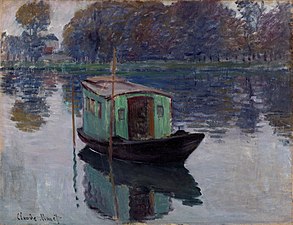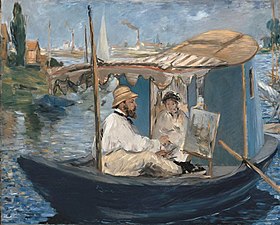
Berthe Marie Pauline Morisot was a French painter and a member of the circle of painters in Paris who became known as the Impressionists.

Oscar-Claude Monet was a French painter and founder of Impressionism painting who is seen as a key precursor to modernism, especially in his attempts to paint nature as he perceived it. During his long career, he was the most consistent and prolific practitioner of Impressionism's philosophy of expressing one's perceptions of nature, especially as applied to plein air (outdoor) landscape painting. The term "Impressionism" is derived from the title of his painting Impression, soleil levant, which was first exhibited in the so-called "exhibition of rejects" of 1874–an exhibition initiated by Monet and like-minded artists as an alternative to the Salon.

Édouard Manet was a French modernist painter. He was one of the first 19th-century artists to paint modern life, as well as a pivotal figure in the transition from Realism to Impressionism.

Impressionism was a 19th-century art movement characterized by relatively small, thin, yet visible brush strokes, open composition, emphasis on accurate depiction of light in its changing qualities, ordinary subject matter, unusual visual angles, and inclusion of movement as a crucial element of human perception and experience. Impressionism originated with a group of Paris-based artists whose independent exhibitions brought them to prominence during the 1870s and 1880s.

Charles-François Daubigny was a French painter, one of the members of the Barbizon school, and is considered an important precursor of impressionism.
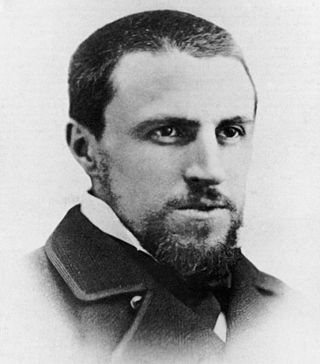
Gustave Caillebotte was a French painter who was a member and patron of the Impressionists, although he painted in a more realistic manner than many others in the group. Caillebotte was known for his early interest in photography as an art form.

Alfred Sisley was an Impressionist landscape painter who was born and spent most of his life in France, but retained British citizenship. He was the most consistent of the Impressionists in his dedication to painting landscape en plein air. He deviated into figure painting only rarely and, unlike Renoir and Pissarro, he found that Impressionism fulfilled his artistic needs.
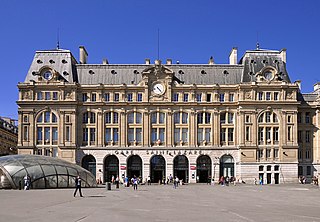
The Gare Saint-Lazare, officially Paris Saint Lazare, is one of the seven large mainline railway station terminals in Paris, France. It was the first train station built in Paris, opening in 1837. It mostly serves train services to western suburbs, as well as intercity services toward Normandy using the Paris–Le Havre railway. Saint-Lazare is the third busiest station in France, after the Gare du Nord and Gare de Lyon. It handles 290,000 passengers each day. The current station building opened in 1889 and was designed by architect Juste Lisch; the maître d'œuvre was Eugène Flachat.
Events from the year 1874 in art.
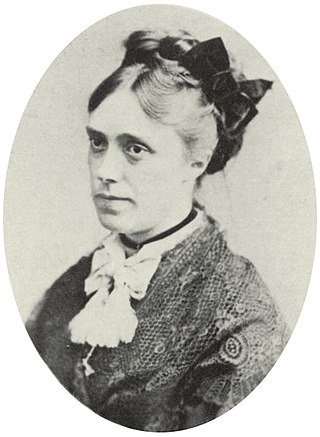
Camille-Léonie Doncieux was the first wife of French painter Claude Monet, with whom she had two sons. She was the subject of a number of paintings by Monet, as well as Pierre-Auguste Renoir and Édouard Manet.

Snow at Argenteuil is an oil-on-canvas landscape painting by the Impressionist artist Claude Monet. It is the largest of no fewer than eighteen works Monet painted of his home commune of Argenteuil while it was under a blanket of snow during the winter of 1874–1875. This painting—number 352 in Wildenstein's catalogue of the works of Monet—is the largest of the eighteen. The attention to detail evident in the smaller paintings is less evident in this larger picture. Instead, Monet has rendered large areas of the canvas in closely like tones and colours of blue and grey. The application of smaller strokes of greens, yellows, reds and darker blues breaks up these large expanses, and the almost choreographed dispersal of these various colours helps bind the picture together. Paint at the depicted road surface is thicker than elsewhere in the painting, and impasto is suggestive of the feel of disturbed snow.

Adolphe Étienne Auguste Moreau-Nélaton was a French painter, art collector and art historian. His large collection is today held in its entirety by French national museums.

Boulevard des Capucines is the title of two oil-on-canvas paintings depicting the famous Paris boulevard by French Impressionist artist Claude Monet, created between 1873-1874. One version is vertical in format and depicts a snowy street scene looking down the boulevard towards the Place de l'Opéra. The other version is a horizontal composition and shows the same street on a sunny winter day; it is housed at The Pushkin State Museum of Fine Arts in Moscow and is believed to be the version that was exhibited at the first Impressionist exhibit in 1874. Monet painted the works from the photography studio of Félix Nadar at 35 Boulevard des Capucines. The elevated vantage point and loose brushstrokes allow the audience to see the commotion of the boulevard from a position high above street level. Certain aspects of the paintings have parallels in the photography of Monet's day and in Japanese prints, which may have influenced Monet.

Boating is an oil-on-canvas painting by French artist Édouard Manet. The painting depicts a man and woman on a sailboat during the summertime. It was painted during in the summer of 1874, during which time Manet was staying on his family's property in Gennevilliers. Art historians have suggested that the woman may be Camille Monet, while the man has often been identified as Manet's brother-in-law Rodolphe Leenhoff.

Claude Monet Painting in His Garden at Argenteuil is an 1873 Impressionist painting by Pierre-Auguste Renoir.

Argenteuil is an 1874 oil on canvas painting by Édouard Manet (1832-1883), first exhibited at the Paris Salon of 1875. It is one of Manet's first works to be regarded as a fully Impressionist painting due to its naturalistic style and its bold palette. The painting depicts a sailor and his companion sitting on a mooring dock surrounded by sailboats, the deep blue water of the Seine, and the town of Argenteuil on the far bank. Art historians have described Argenteuil as a response to Claude Monet's depiction of similar subject matter.

Claude Monet Painting in his Studio or Monet in his Boat is an 1874 oil on canvas painting by Édouard Manet. It shows his friend Claude Monet painting in his 'studio-boat' with his wife. This was an old boat Monet had bought around 1871 or 1872, from which he observed the light on the Seine – Daubigny also had a studio-boat called the Bottin. With The Monet Family in their Garden and Argenteuil, it was one of a number of paintings produced during a summer Manet spent with Monet. The work is now in the Neue Pinakothek in Munich.

Eugène Manet on the Isle of Wight is an oil-on-canvas painting by French artist Berthe Morisot. The painting depicts a man, Eugène Manet, relaxing at a hotel window, with vases visible on the parapet. Manet is looking out the window as two elegantly dressed women in white pass by. Several boats appear at the shoreline.

The Train in the Snow, or Le train dans la neige, is a landscape painting by the French Impressionist artist Claude Monet. The work depicts a train surrounded by snow at the Argenteuil station in France. Art historians see the work as a significant example of Monet's efforts to integrate nature and industry in his work. Many historians believe that Monet, out of all of the notable nineteenth century artists, made the most paintings of trains in his lifetime.

The First Impressionist Exhibition was an art exhibition held by the Société anonyme des artistes peintres, sculpteurs, graveurs, etc., a group of nineteenth-century artists who had been rejected by the official Paris Salon and pursued their own venue to exhibit their artworks. The exhibition was held in April 1874 at 35 Boulevard des Capucines, the studio of the famous photographer Nadar. The exhibition became known as the "Impressionist Exhibition" following a satirical review by the art critic Louis Leroy in the 25 April 1874 edition of Le Charivari entitled "The Exhibition of the Impressionists". Leroy's article was the origin of the term Impressionism.



